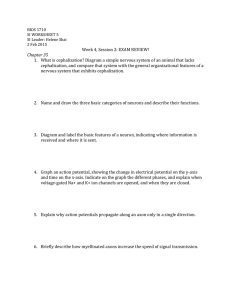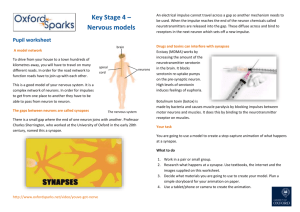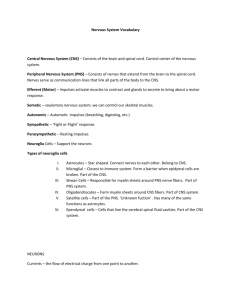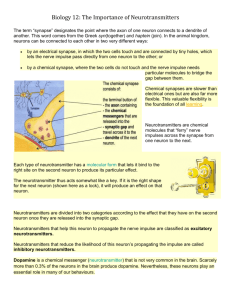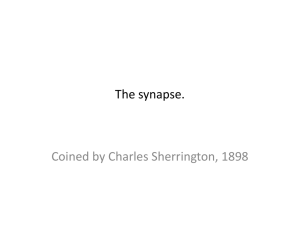BIOS 1710
advertisement
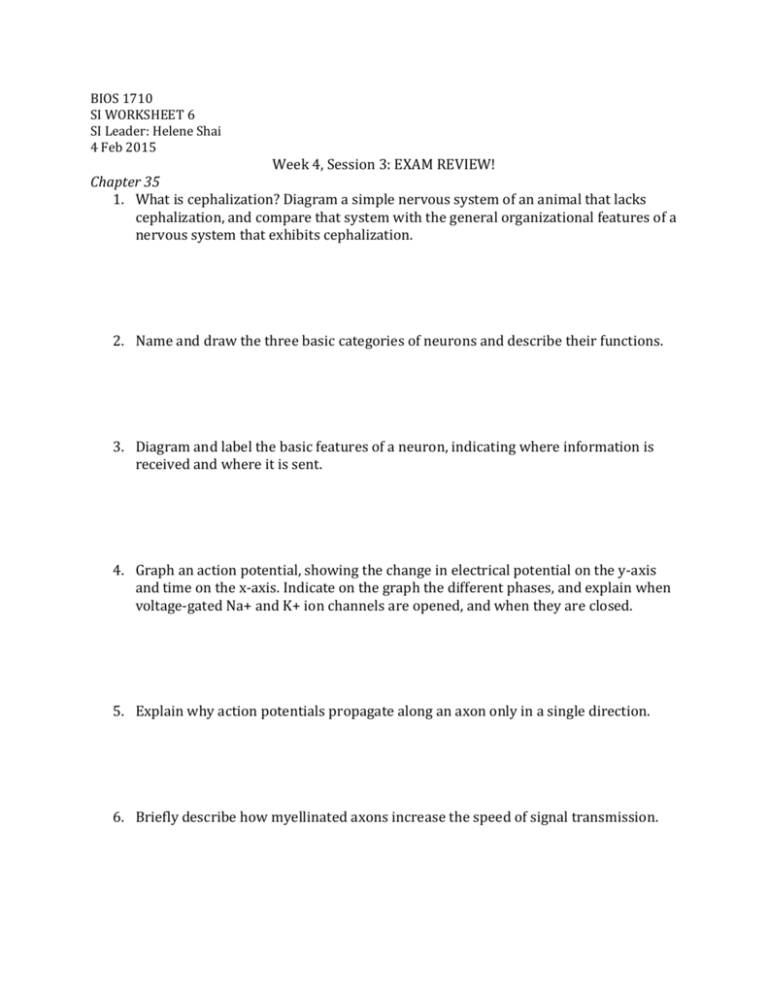
BIOS 1710 SI WORKSHEET 6 SI Leader: Helene Shai 4 Feb 2015 Week 4, Session 3: EXAM REVIEW! Chapter 35 1. What is cephalization? Diagram a simple nervous system of an animal that lacks cephalization, and compare that system with the general organizational features of a nervous system that exhibits cephalization. 2. Name and draw the three basic categories of neurons and describe their functions. 3. Diagram and label the basic features of a neuron, indicating where information is received and where it is sent. 4. Graph an action potential, showing the change in electrical potential on the y-axis and time on the x-axis. Indicate on the graph the different phases, and explain when voltage-gated Na+ and K+ ion channels are opened, and when they are closed. 5. Explain why action potentials propagate along an axon only in a single direction. 6. Briefly describe how myellinated axons increase the speed of signal transmission. 7. Diagram a chemical synapse, labeling the vesicles that contain neurotransmitter molecules and the receptors that bind the neurotransmitter to produce either an inhibitory or excitatory stimulus in the postsynaptic cell. 8. Describe how vertebrate nervous systems are organized into voluntary and involuntary components, listing which functions of an animal are controlled by each component. 9. Diagram a simple circuit that includes a sensory neuron that synapses with a motor neuron to produce a reflex. Indicate where in the nervous system this synapse is found. Chapter 36 10. Diagram a generalized receptor neuron, showing how it changes its firing rate in response to detected stimuli. 11. Describe the three main stages by which sound is detected and coded by the mammalian ear. 12. Compare and contrast the roles of rod cells and cones cells in the retina. 13. Describe the role of the cornea and lens in vertebrate eyes. 14. Describe three different types of eye in animals. 15. Draw the brain, label the lobes, and describe their primary functions. 16. Describe the importance of topographic mapping of sensory input to the cortex, using the primary somatosensory cortex as an example. Chapter 37 17. Diagram a sarcomere, showing the basic organization of thin (actin) and thick (myosin) filaments. Indicate on your diagram the regions where myosin crossbridges form with actin. 18. Describe the sequence of events that occurs when an action potential arrives at a muscle fiber’s motor endplate, causing the muscle to be depolarized. 19. Name the two basic structural elements common to all animal skeletons. 20. Compare and contrast three features of an exoskeletons and an endoskeleton. 21. Identify the two primary components of bone tissue and explain how each of these contributes to a bone’s strength, stiffness, and resistance to fracture. Chapter 39 22. Diagram the four basic steps of O2 transport from an animal’s respiratory medium (air to water) to its cells. 23. Explain how the tracheal respiratory system of insects enables high metabolic rates. Explain how gill respiration is facilitated by unidirectional water flow, where as lung ventilation can depend on bidirectional airflow. Clicker Questions 1. Neuronal stimuli are received by: A. Dendrites B. Axons C. Neurotransmitters D. Cell bodies 2. The puffer fish toxin, tetrodotoxin blocks voltage-gated Na+ channels. It is a neurotoxin because A. It destroys the resting membrane potential B. It prevents the repolarization of the membrane back to resting potential after an action potential C. It prevents the transmission of an action potential along an axon D. It allows the action potential to return in the direction it came from (no refractory period). 3. Which of the following is found in the synapse? A. Nucleus B. Neurotransmitter C. Cell body D. Myelin sheath 4. Inhibitory synapses are important for: A. Transmitting relevant information between nerve cells B. Filtering out unimportant information C. Coordinating movement D. Increasing the number of action potentials fired. 5. Which region of the brain is larger in humans and primates than in other vertebrates? A. Cerebellum B. Midbrain C. Spinal cord D. Cerebral cortex 6. Sensory transduction requires: A. A change in membrane potential B. Reaction of a receptor protein with a stimulus C. Alteration of the conformation of a channel protein D. All of the answer options are correct 7. Hair cells function by: A. Firing action potentials directly B. Releasing neurotransmitters C. Stabilizing homeostasis D. Using chemosensory receptors 8. The eyes of nocturnal predators are likely to have: A. A higher concentration of rods than cones B. A higher concentration of cones than rods C. More bipolar cells than those animals that hunt during the day D. More ganglion cells than those animals that hunt during the day 9. What is the basic contracting unit of a skeletal muscle? A. Sarcomere B. Myofibril C. Actin filament D. Myosin 10. Muscle force is increased by: A. Increased motor neuron firing rate. B. Increased number of activated motor units. C. Increasing the distance between muscle fibers. D. A and B 11. A (n) ________________ exoskeleton made of chitin protects and limits water loss, but has limited ability to grow and repair. A. Invertebrate B. Vertebrate C. Mammalian D. Hydrostatic 12. The partial pressure of a gas: A. Is its fractional concentration multiplied by the overall, atmospheric pressure B. Is a measure of how quickly a gas moves across a respiratory surface C. Is equivalent to the total atmospheric pressure D. Is the difference in concentration of that gas inside and outside of a cell 13. Lamellae are structures that are present in: A. The lungs of fish B. The lungs of mammals C. The tracheas of insects D. The gills of fish Practice Questions 1. Approximately how many nerve cells does a human have? a. 10 million b. 100 million c. 10 billion d. 100 billion e. We do not have a good estimate. 2. Which excitatory neurotransmitter is responsible for muscle contraction in vertebrates? a. Dopamine b. Norepinephrine c. Nitrous oxide d. Glutamate e. Acetylcholine 3. The area within the neuron where stimuli are summed is called the: a. Dendrite. b. Cell body. c. Axon terminal. d. Axon hillock. e. Synapse. 4. Which of the following is true of chemical synapses? Select all correct choices. a. They are more common than electrical synapses. b. Their vesicles fuse with the presynaptic membrane to release neurotransmitters. c. Once released, their neurotransmitter molecules may return to the presynaptic cell. 5. At which synapse in the knee-jerk reflex would you expect to find an IPSP? a. The synapse between the sensory neuron and the extensor muscle motor neuron b. The synapse between the extensor muscle motor neuron and the extensor muscle c. The synapse between the sensory neuron and the interneuron d. The synapse between the interneuron and the flexor motor neuron 6. Which of the following sets of terms belong together? a. Involuntary, autonomic, sympathetic b. Voluntary, autonomic, parasympathetic c. Involuntary, somatic, parasympathetic d. Voluntary, somatic, sympathetic 7. Imagine you genetically engineered a neuron to produce voltage-gated Na+ and K+ channels that had the same opening times in response to a change in voltage. How would that change the recording in the Figure above? a. The peak voltage would be higher. b. The peak would occur over a longer period of time. c. The period of hyperpolarization would be longer. d. No action potential would be generated. e. Threshold values would increase. 8. Tetraethylammonium (TEA) is a drug that blocks voltage-gated K+ channels. Its Effect on the figure to the right would be to a. Prevent the depolarization seen in A b. Change the resting membrane potential c. Prevent the rapid voltage drop seen in the interval B-D d. Cause even greater hyperpolarization at D 9. Whether a neurotransmitter has an inhibitory or excitatory effect on a postsynaptic cell depends on a. The type of neurotransmitter b. The nature of the postsynaptic receptor and channel c. The concentration of neurotransmitter in the synaptic cleft 10. In a neuron, what creates the concentration gradient favoring the outflow of K+? a. Ligand-gated Na+/K+ channels b. Voltage-gated K+ channels c. Leakage K+ channels d. The Na+/K+ ATPase e. Voltage-gated Na+ channels Chapter 36 1. How are thermoreceptors involved in homeostasis? a. They have a role in blood pressure regulation. b. They play a role in regulating body temperature. c. They control electrolyte balance of the body. d. Once these signals are processed, the brain sends signals to avoid the pain. 2. How are thermoreceptors involved in homeostasis? a. They have a role in blood pressure regulation. b. They play a role in regulating body temperature. c. They control electrolyte balance of the body. d. Once these signals are processed, the brain sends signals to avoid the pain. 3. Which one of the following are muscles that can contract, making the lens rounder to focus on close objects, and can relax to flatten the lens, enabling focus on distant objects? a. Iris b. Lens muscles c. Ciliary muscles d. Lateral rectus muscle 4. The steps necessary for hearing include (1) amplification of sound waves, (2) transfer of sound vibrations to fluid pressure waves, and (3) mechanoreception by hair cells of the cochlea. How are the sound vibrations transferred to fluid pressure waves? a. By the bones of the middle ear b. Through the oval window c. By the tympanic membrane d. By the action of the vestibular system 5. The human retina has several layers of cells/tissues in the eye. What is the order of appearance of these cells from the front (where light hits first) to the back of the eye? a. Rods and cones; bipolar cells; pigmented epithelium; ganglion cells b. Ganglion cells; bipolar cells; rods and cones; pigmented epithelium c. Rods and cones; ganglion cells; bipolar cells; pigmented epithelium d. Pigmented epithelium; rods and cones; ganglion cells; bipolar cells 6. Multiple sensory receptors can synapse on a single neuron. The receiving neuron has a firing rate proportional to the number of signals received. Which of the following is this an example of? a. Temporal summation b. Spatial summation c. Action potential d. Hyperpolarization 7. Which one of the following structures is found in the hindbrain? a. Cerebral cortex b. Cerebellum and pons c. Limbic system d. Thalamus and hypothalamus 8. Where is the visual cortex of the brain found? a. Frontal lobe of the cerebrum b. The occipital lobe c. The parietal lobe d. The cerebellum 9. The ability to alter the connections between neurons is known as: a. Long-term memory. b. Synaptic plasticity. c. Long-term potentiation. d. All of the answer options are correct. 10. During long-term potentiation the release of the neurotransmitter glutamate triggers the opening of sodium and calcium channels in the postsynaptic cell, increasing ion flow. What type of channel is responsible for this increase in ion flow? a. Voltage-gated ion channel b. Ligand-gated ion channel c. Light-gated ion channel d. Pump protein Chapter 37 1. How do muscles produce the force that results in movement? a. By activating neurons b. By shortening c. By responding to hormones d. By elongating 2. Which of the following would you find in the lumen (inner open space) of the transverse tubule (T-tubule) of vertebrate skeletal muscle? a. Extracellular fluid b. Cytoplasm c. Actin d. Myosin e. Sarcoplasmic reticulum 3. The role of Ca2+ in the control of vertebrate skeletal muscle contraction is to a. Block the ATP-binding site on myosin heads enabling muscles to relax. b. Bind tropomyosin and break actin-myosin cross bridges. c. Change the conformation of myosin heads, thus causing microfilaments to slide past each other. d. Change the conformation of the troponin-tropomyosin complex, exposing myosinbinding sites. e. Cause depolarization of the T tubule system. 4. Vertebrate skeletal muscle is a. Under the control of the sympathetic nervous system. b. Under control of the parasympathetic nervous system. c. Dually controlled by sympathetic and parasympathetic neurons. d. Dually controlled by the autonomic and somatic nervous systems. e. Under control of the somatic, and not the autonomic nervous system. 5. Cross-bridges form between the contractile proteins of the muscle cell. The movement of cross-bridges shortens the muscle fiber. What two proteins participate in crossbridge formation? a. Actin and myosin b. Troponin and tropomyosin c. Troponin and myosin d. Tropomyosin and actin 6. What stimulates a muscle cell to contract? a. An impulse from a sensory neuron b. An impulse from a motor neuron c. Auto-depolarizing cells in the membrane of muscle cells d. Hormones 7. The binding of neurotransmitter to receptors on the muscle cell causes: a. An influx of sodium ions. b. An influx of potassium ions. c. An efflux of sodium ions. d. An efflux of potassium ions. 8. The cuticle of most insects is composed of: a. Structural proteins. b. Pectin. c. Chitin. d. Waxy lipids. 9. Which of the following is the portion of the vertebrate skeleton that includes the skull, vertebrae, and ribs? a. The axial skeleton b. The central skeleton c. The appendicular skeleton d. The trunk 10. A sample of muscle tissue shows large-diameter fibers that are white in color. Which of the following characteristics would also be associated with this tissue? a. High rates of ATP hydrolysis b. Greater resistance to fatigue c. Aerobic respiration d. Abundant mitochondria e. All of the answer options are correct Chapter 39 (part): 39.1 & 39.2 1. Diffusion is an effective way to exchange gases over short distances, but not over longer distances. a. True b. False 2. Imagine a planet that has a similar atmospheric pressure to Earth (760 mmHg), but different concentrations of gases in its atmosphere. On this hypothetical planet, oxygen makes up 10% of the atmosphere, nitrogen makes up 15%, and carbon dioxide makes up the remaining 75%. Based on this information, what is the partial pressure of oxygen on this new planet? a. 76 mmHg b. 114 mmHg c. 160 mmHg d. 571 mmHg e. 646 mmHg 3. During inhalation the diaphragm contracts and moves downward. What effect does this have on the pressure in alveoli in the lungs? a. Pressure in the alveoli increases to values higher than atmospheric pressure b. Pressure in the alveoli decreases to values lower than atmospheric pressure c. Pressure in the alveoli does not change. 4. At any given point along the length of the gill lamella, how does the pO2 of the blood flowing through the blood vessels in the lamella compare to the pO2 of the water flowing over the gill lamella? a. The pO2 of the blood is lower than the pO2 of the water. b. The pO2 of the blood is higher than the pO2 of the water. c. The partial pressure of oxygen in the blood is equal to the pO2 of the water. d. The pO2 of the blood is variable and cannot be compared to the pO2 of the water. e. The pO2 of the blood never exceeds 50% of the pO2 of the water. 5. When you are running on a treadmill at Ping Center, the respiratory control center in your brainstem increases your breathing rate to restore Po2 and Pco2 levels in your tissues to their resting levels. It does so because sensory receptors in the brainstem detect changes in the blood and cerebrospinal fluid. The principal change that these neurons sense is: a. A drop in Po2 b. A rise in Pco2 c. A rise in pH d. A drop in HCO3-
